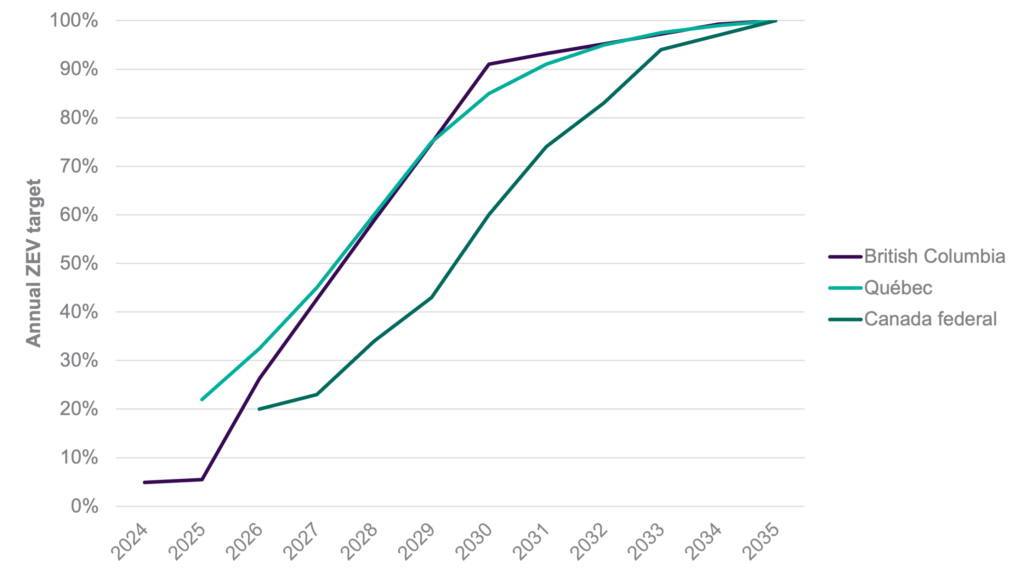As an original signatory to the Zero Emission Vehicles (ZEV) Declaration, Canada made an ambitious pledge to accelerate the adoption of ZEVs within its jurisdiction. Now, two years later, their recently released Electric Vehicle Availability Standard cements their commitment to transition their light-duty vehicle sector to zero-emission vehicles.
Final regulations were published in December 2023 and require that all new passenger cars, SUVs, and light trucks offered for sale must be zero-emission by 2035. Starting with the model year 2026, 20% of the new vehicles offered for sale to Canadians must be zero-emission vehicles (ZEVs), defined as battery electric (BEV), plug-in hybrid (PHEV), and hydrogen fuel cell electric vehicles (FCEV). The requirement rises annually and reaches 60% by 2030 and 100% by 2035. The federal rule follows British Columbia and Québec provinces, who are also both signatories to the ZEV Declaration under the subnational category, which have similar ZEV standards in place. British Columbia’s Zero Emission Vehicles Act targets 26% ZEV sales for new light-duty vehicles by 2026, 90% in 2030, and 100% by 2035. Similarly, Québec proposed an amendment to the Zero Emission Vehicle Standard with targets increasing annually to 85% in 2030 and 100% in 2035, alongside increasing the province’s vehicle target from 1.6 million to 2 million ZEVs on its roads by 2030.
“Canadians are making the switch to zero-emission vehicles,” says the Honourable Pablo Rodriguez, Minister of Transport. “Introducing the Electric Vehicle Availability Standard will ensure that Canadians have more to choose from—and more affordable options—when choosing a zero-emission vehicle. These measures will help create jobs across Canada and bring us closer to our ambitious sales targets for zero-emission vehicles.”
Canada has outlined their roadmap to reach its emission reduction target of 40% below 2005 levels by 2030 and net-zero emissions by 2050 in their 2030 Emissions Reduction Plan. Transportation accounts for about a quarter of Canada’s GHG emissions, with light-duty vehicles producing nearly half of these emissions. With the new rule, carbon dioxide emissions from light-duty vehicles could be reduced by 82% by 2050 compared to 2020 levels, according to the International Council of Clean Transportation who serves as secretariat of the
The regulation will bring significant health benefits to the country by reducing air pollutant emissions from road vehicles, which currently account for 1,200 premature deaths and 210,000 asthma symptom days annually, primarily affecting vulnerable populations living close to high-traffic areas. Light-duty vehicles are responsible for $9.5 billion in health costs related to the harmful emissions from road transportation per year.
Annual ZEV sales targets in British Columbia, Quebec and Canada, 2024-2035

Source: International Council on Clean Transportation, February 21, 2024.
Canada’s new regulation will accelerate electrification across the country
The new ZEV regulations will be the catalyst for ZEV adoption nationwide by the end of this decade or sooner. Battery-electric and plug-in hybrid vehicle sales represented 11% of passenger car sales in 2023, up from 8% in 2022. The $2 billion in incentives for Zero Emission Vehicle Program provides up to $5,000 for buying or leasing BEV, FCEV, and longer-range PHEVs and up to $2,500 for shorter-range PHEVs.
Canada has taken an important step towards ensuring adequate charging infrastructure availability to match EV growth. The government has allocated a combined $1.2 billion in funding to the Zero Emission Vehicle Infrastructure Program, the Charging and Hydrogen Refueling Infrastructure Initiative, and the Electric Alternative Fuel Infrastructure. With the additional funding, 43,000 public charging stations, more than double the amount installed public chargers in the third quarter of 2023, will be built.
With the new regulation, Canada has joined a group of leading governments in locking in the pace of the ZEV transition, including California and 13 U.S. states, the European Union, and the United Kingdom. As a signatory to the ZEV Declaration, the new ZEV standard reinforces Canada’s commitment to achieving 100% new zero-emission light-duty vehicle sales by 2035.

